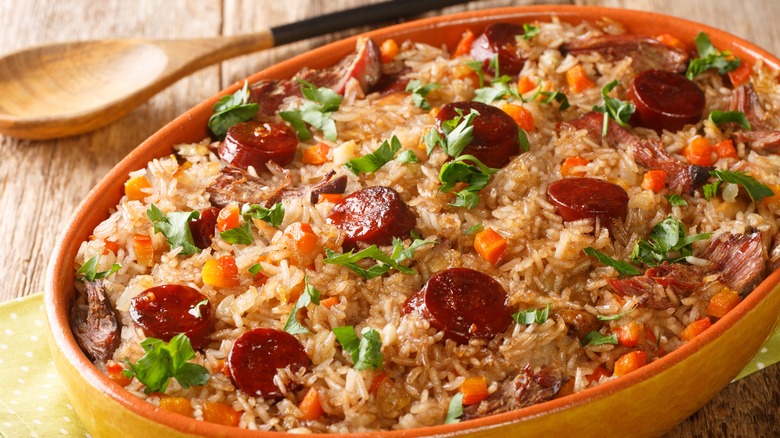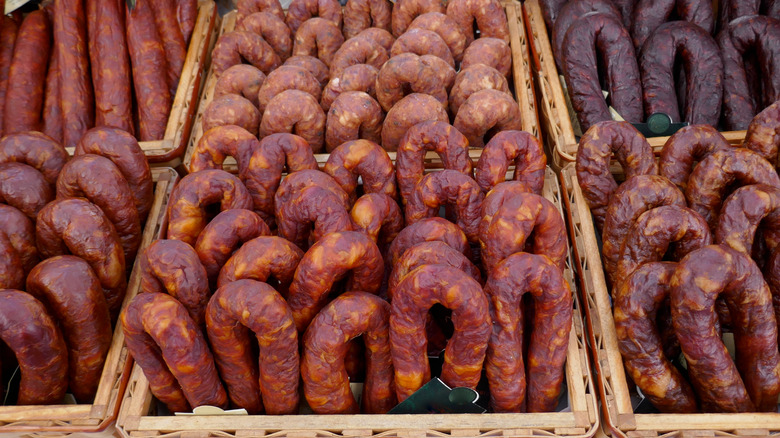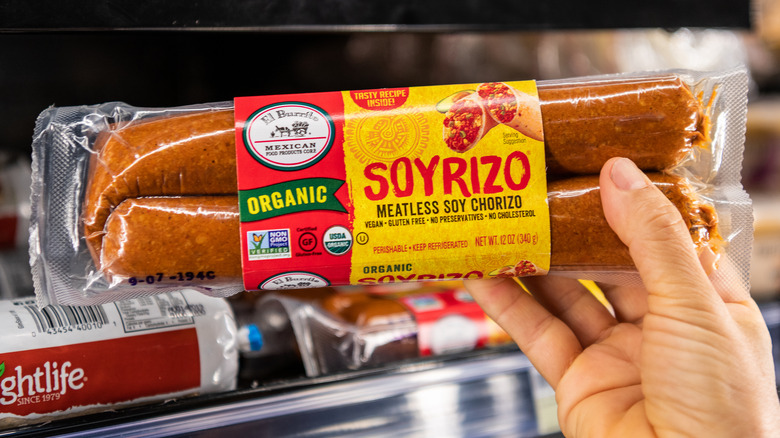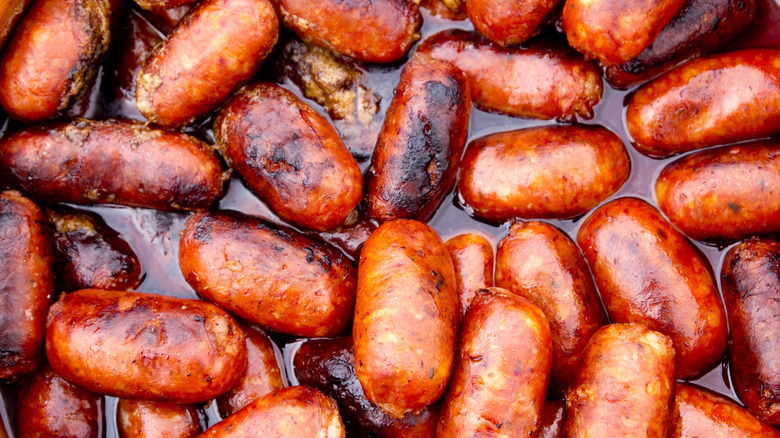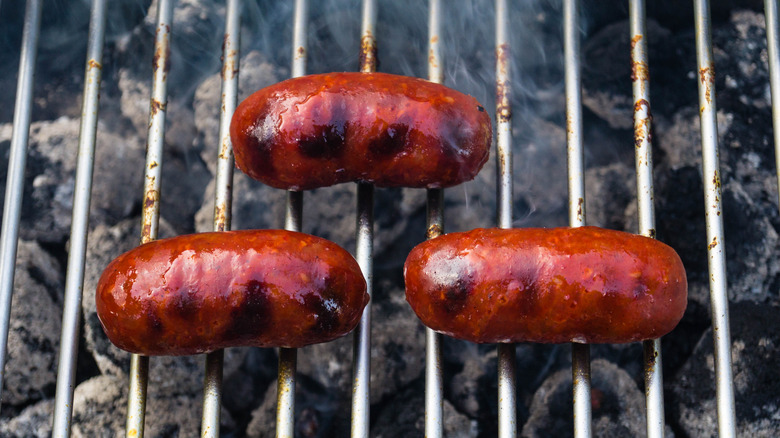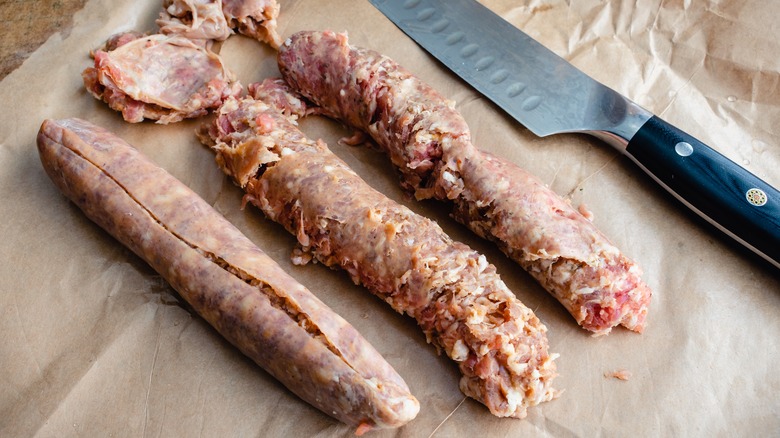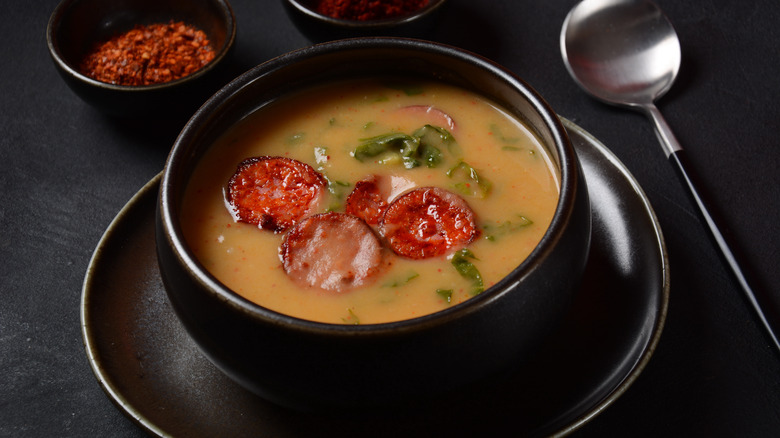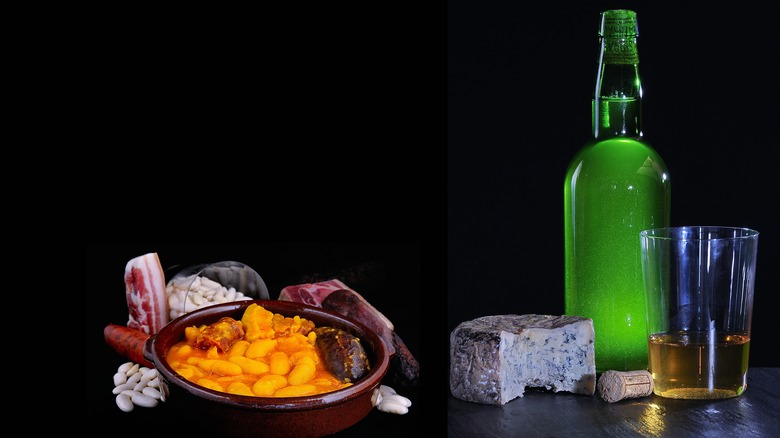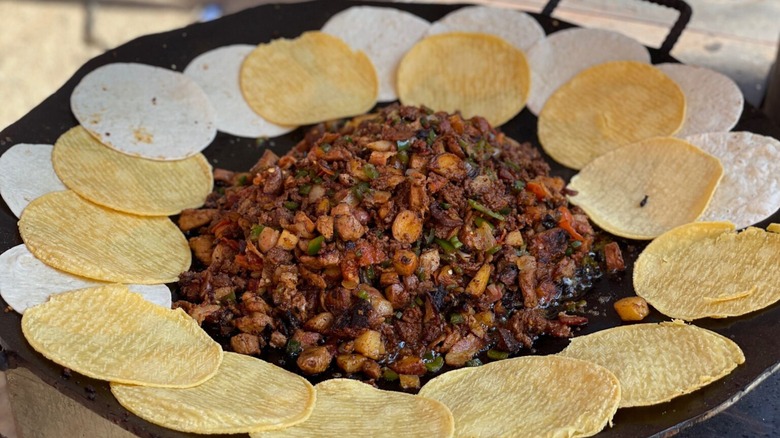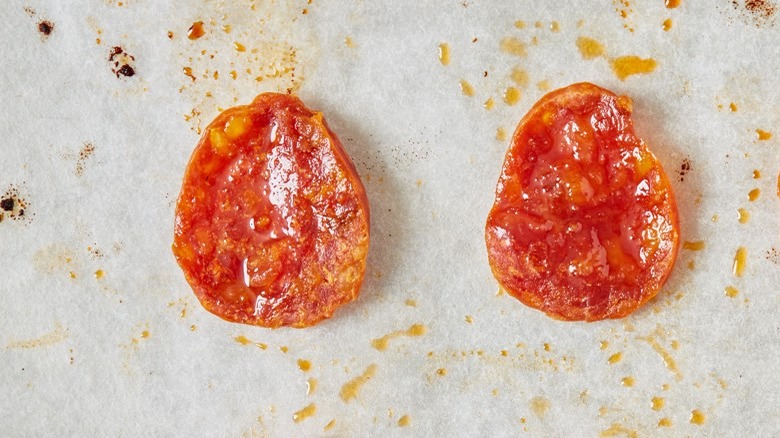11 Tips You Need When Cooking With Chorizo
Chorizo is an intensely-flavored sausage or sausage blend that comes to us from Spanish and Latin American cuisines. Chorizo is usually made from pork, but it's also made with other meats and you can even get some made from soy. Putting the type of protein aside, the sausage is pretty much defined by the incorporation of chilies and signature spices.
It's an incredibly versatile sausage that can bring a lot to many different dishes if used correctly. There are several different types of chorizo and they are not interchangeable. Some types of chorizo are cured, semi-cured, or cooked, while others are raw. The type of chorizo you have will dictate whether or not it needs to be refrigerated and how long it will last. Cured chorizo in a vacuum-sealed package will keep for about 90 days in a cool, dry place, per The Black Hoof. Raw chorizo has raw meat in it, so you do the math. Because chorizo is spicy and heavily seasoned, it usually doesn't need any additional seasoning. Chorizo is also very fatty, and cooking it releases a large amount of rendered fat. These tips will help you navigate this delicious ingredient and find plenty of delectable uses for it.
Understand the difference between Spanish and Mexican chorizo
Even though they have the same name, Spanish and Mexican chorizo are two very different things. Made from fatty cuts of pork, Spanish chorizo is hard and cured like a salami. It gets its signature red color from hot or sweet smoked paprika. Spanish chorizo is also typically made with herbs, garlic, and white wine. This type of sausage is often fermented or smoked before being cured. Fully-cured Spanish chorizo is often served sliced, possibly as part of a charcuterie board.
Mexican chorizo is usually raw and made with pork, although beef and soy are used to make it too. Getting its signature red color from spicy red peppers, Mexican chorizo often includes guajillo chilies, cinnamon, cloves, garlic, oregano, and vinegar. Mexican chorizo is usually removed from its casing before being cooked. Some types of Mexican chorizo do not come in a casing and instead are sold as a fresh sausage blend wrapped in plastic. Because it is not cooked as a sausage, you typically find Mexican chorizo as seasoned chunks of cooked meat in a dish.
Select a good brand of Mexican chorizo for cooking
There are a number of Mexican chorizo brands out there, and some are better than others. In our recent ranking of chorizo brands, we found the sausage blend from Cacique is one of the best. Although Cacique doesn't exactly use premium ingredients in its chorizo blend, we found it had the perfect balance of meat and fat. We also found Cacique has the right amount of acidity and a pleasing texture.
Other brands that we tested were less impressive. The chorizo from El Mexicano was too fatty, transforming into bits of meat in a pool of grease shortly after hitting a hot pan. On the other hand, the chorizo from Cantella's wasn't fatty enough for our ace reviewer. While it's a poor choice for breakfast tacos and other dishes that call out for grease, Cantella's chorizo would be a good pairing for steamed clams or huevos con chorizo. Incidentally, we found that the soy chorizo from El Burrito was a handy vegan alternative.
Cook raw and semi-cured chorizo to render delicious fat
Proper cooking helps to develop the flavors of semi-cured and raw chorizo. But more importantly, cooking these chorizos also releases delicious rendered fat that can be used to flavor other ingredients in a dish.
Chorizo is usually cooked in a bit of neutral oil over medium heat. If you are cooking chorizo links, The Fork Bite recommends cooking them whole and slicing or chopping them later to prevent the sausages from completely drying out. If your sausage starts to stick, add a bit of water to the pan to release it and keep the chorizo moist. Flip links a few times during cooking to ensure they cook evenly. When the chorizo changes from red to golden brown, use a knife or a meat thermometer to see if it is fully cooked.
Chorizo should be cooked to the point it releases rendered fat. If you cook chorizo along with other ingredients, like chopped onions, those ingredients should fry in the oil and soak up some of its flavors.
Make chorizo oil
If you fry chorizo in a pan and there is leftover oil, save the oil as a way to add flavor to future dishes. Because the rendered fat released by chorizo can bring so much flavor to a dish, some chefs cook chorizo in canola or some other type of neutral oil, then save the chorizo oil for later use. It's as simple as heating some chopped chorizo in grapeseed or other neutral-tasting oil. The chorizo fat will render into the oil and infuse it with flavor. After the chorizo has shriveled and released all of its fat, the chorizo bits can be strained out and the oil can be saved for later.
Chorizo oil can be used just like any other cooking oil. You can use it to cook scrambled eggs, pan-fry fish, or drizzle it over potatoes. One especially creative use for chorizo oil is using it to make mayonnaise. Emulsifying egg yolks with chorizo oil results in a deeply flavorful, light orange mayonnaise that goes well on just about anything.
Grill for intense flavor
Grilling chorizo gives it a bit of smoke and char to balance out the sausage's spicy tang. When it comes to grilling, one of the mistakes everyone makes with sausage is pricking the casing before throwing it on the grill. In the past, sausages contained a lot of liquid and pricking the casing allowed steam to escape, which prevented the sausage from exploding. However, most sausages today, especially chorizo, do not have a lot of moisture. As a result, the only thing pricking a casing does is release rendered fat, making your sausage sad and shriveled.
It's also a bad idea to cook sausage with high heat by placing it directly on the hottest part of the grill. Par-boiling chorizo sausage for two minutes before placing it on the grill can help prevent the sausage casing from splitting open. You could also start cooking your chorizo slowly. Placing a sausage first over indirect heat and then on direct heat allows the casing to expand and contain the meat cooking inside.
Take chorizo out of its casing for a tasty sausage blend
Part of the appeal of eating sausage is the satisfying snap that comes with biting into it. However, a sausage casing doesn't have any flavor, and cutting it open to take out the meat opens more possibilities for cooking with chorizo.
Cutting open a chorizo sausage to remove the meat inside seems like a pretty straightforward affair, but if you've ever tried to do it, you know things can get a little messy. Sausage maker Johnsonville recommends you start by cutting the sausage from end to end with the tip of a knife. Make a cut that is deep enough to break the casing but not so deep that it cuts all the way through the sausage. Flip over the chorizo cut side down, and grab each end with your thumb and forefinger. Pull back the casing to release the meat.
One of the best uses for your freshly-released sausage meat is in a recipe for chorizo-egg hash. Sauté the chorizo meat with hash brown potatoes, onions, and chilies in a cast-iron skillet. Once the chorizo and potatoes are cooked, crack a few eggs into the pan, cover the pan, and cook until the whites are just set.
Make a Spanish classic or pair chorizo with seafood
Paella is the national dish of Spain and a classic paella recipe is a great way to use chorizo. Paella is named after the pan in which it's cooked and started as a peasant dish with humble ingredients like rice, beans, vegetables, and game meats. As the popularity of paella began to spread into upper-class Spanish society, it started to take on more luxurious ingredients like saffron, seafood, and sausage.
The classic way to make paella is over an open fire. Wood smoke from a fire gives paella the perfect finishing touch that takes the dish to the next level. If that's not possible, you can make paella on the grill. Simply cook your seafood, sausage, and any other meats directly on the grill, then add them to the pan at the end after all the other ingredients have cooked.
The cornerstone of seafood paella is the combination of seafood and chorizo. It's a combination that also translates well to other dishes. BBC Good Food recommends making a pot of Spanish meatballs with clams, chorizo, and squid — or using the sausage to make a salad with squid and chickpeas.
Amp up savory soups
It should come as no surprise that adding chorizo to soup infuses a ton of flavor, and there are many robust soups that feature this savory sausage. Chorizo and corn soup is a classic Mexican dish that many children grow up eating (via Amigo Foods). Like most classic dishes, this soup is very easy to make. Simply toss bell peppers, garlic, onions, and stock into a pot along with corn and chorizo. This soup recipe can vary from family to family, and some recipes include a small amount of mashed potatoes to give a consistency reminiscent of chowder.
Soups are a major part of Mexican cuisine, and something you may have never thought to order at a Mexican restaurant. In addition to chorizo and corn soup, other classic soups you should look for at Mexican restaurants include caldo de pollo (chicken soup), sopa de frijol (black bean soup), sopa de tortilla (tortilla soup), and pozole verde, a vibrant Mexican soup made with tomatillos.
Pair chorizo with Riesling or a funky Spanish cider
While it may not be a classic wine and food pairing like champagne and oysters, chorizo and Riesling are a good match. According to Forbes, the residual sugar in Riesling helps to tame spicy chorizo. A Riesling with notes of tropical fruit also pairs well with the sausage's signature paprika flavor.
One of the things you need to know about cider is that it pairs well with food, just like wine. According to Vinepair, funky Spanish cider from Asturias will bring out the rustic notes of chorizo, especially when paired with a funky sheep's milk cheese called Torta de Casar. Spanish cider from this region tends to be acidic and reminiscent of vinegar. These ciders are also unfiltered, giving them a sour funkiness. The taste of Spanish cider can be an acquired one, but fans say they reveal nuanced flavors and aromas once you get a taste for them.
Make discada, a Southwest border classic
Somewhat resembling a wok, a discada is large Tex-Mex cooking pan that came out of the tradition of using circular plow disks to cook food (via Southwestdisk.com) over a hot flame. It's commonly used to make discada norteña or discada Mexicana, a street food dish made of stir-fired meats and vegetables served in a tortilla. Also known simply as discada, this street food is such a cult classic in the Texas-Mexico border region, you can find pre-packaged meat blends in the local market.
Recipes for discada can vary, but most include several different kinds of meat, including steak, ham, bacon, and sliced hot dogs. But one of the most essential meats in discada is Mexican chorizo. Full of fat, and, quite frankly, additives, Mexican chorizo releases an oily cooking liquid that ties together all of the other ingredients. Served in toasted tortillas, discada has all the hallmarks of great street food: meatiness, saltiness, and spiciness. One street food vendor in Austin, Texas serves discada with a slice of pineapple that cuts through all the savoriness (via Texas Monthly).
Make chorizo crisps
Slicing cured or semi-cured chorizo sausage very thinly and baking the slices to a crisp gives you a highly poppable snack food. If you're looking to make chorizo crisps, put the slices between two paper-lined baking trays to keep them from curling up as they bake. In addition to being a snack food, chorizo crisps can also be used to garnish fish, chicken, or vegetable dishes. Chorizo crisps are also shelf-stable for up to a week.
It might sound odd to suggest making a meat-based, shelf-stable snack food, but chorizo crisps aren't very different from pork rinds. The truth about pork rinds and chorizo crisps is that they aren't all that bad for you. Containing zero carbs and high levels of protein, both snacks are keto friendly. That being said, both also contain a lot of salt and fat. Therefore, it's a good idea to eat these snacks in moderation.
